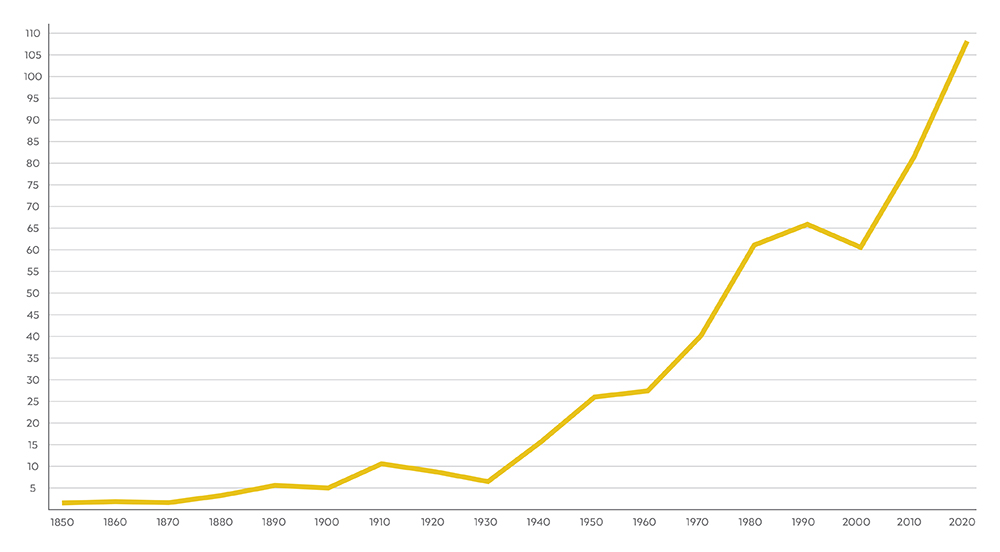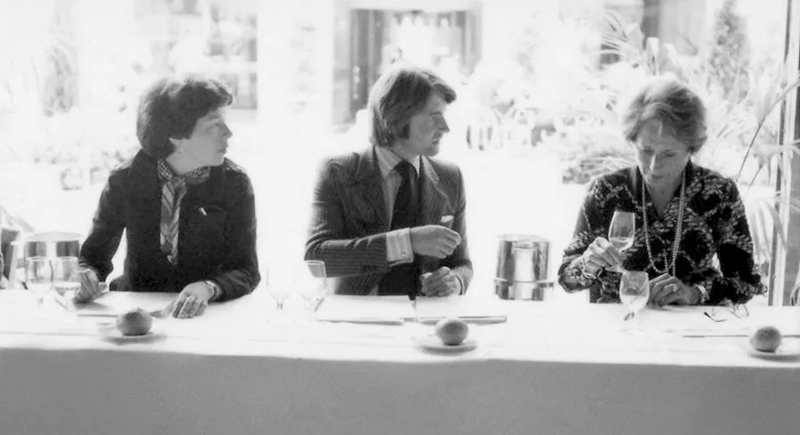WINE
In 2022, California shipped almost 270 million cases of wine around the world, collecting over $50 billion. The United States is the fourth largest producer of wine (behind France, Italy, and Spain) and the number one consumer of wine. But this wasn't always the case. In the early days of the country, Thomas Jefferson fought to create a culture that enjoyed wine, believing the United States would become more refined as a society if it were more like France. His dream would become a reality, but only after two key marketing ideas were introduced in the 20th century.
Early European immigrants to the American continent brought wine with them, but found indigenous grapes of inferior quality and environments too harsh to support vineyards. Despite various attempts to create a wine industry, over 95% of all wine in the United States was imported through the late 19th century. As such, wine was viewed as too expensive for most people, so the United States was a whiskey nation. Whiskey was consumed 13 times more than beer and 23 times more than wine.
When Americans moved across the country in the 1800s and settled in California, they discovered a climate that was almost identical to the Mediterranean shores of France and Italy, and began successfully growing vineyards that seemed to produce similar quality wine. Wine consumption modestly increased to 5 million gallons per year, but still represented only 6% of all alcohol. In 1900, beer began to outpace whiskey as the American drink of choice. Wine reached a peak of just over 10 million gallons per year right before Prohibition was enacted in 1920, which essentially ended the wine industry in the U.S.
U.S. WINE CONSUMPTION IN MILLIONS OF GALLONS

It would get its first resurrection with the help of Frank Schoonmaker. Schoonmaker was an American who spent most of Prohibition traveling throughout Europe, learning to understand and love wine. He returned to New York City in the early 1930s, began writing extensively about wine, and opened a curated wine business. To diversify his collection, he traveled to California to investigate its wines. He discovered the remnants of an industry that had huge potential. All it needed was a consumer base. Schoonmaker's greatest contribution to the international wine community was a simple one. All wineries up to that point copied the naming conventions of the Old World, borrowing the names of regions that had nothing to do with the United States, like Burgundy, Chablis, and Rhine. Schoonmaker felt that the grape varieties contributed more to the character of the wine than the geography, so he advocated for naming wines after their grapes, like Pinot noir, Chardonnay, and Riesling. The marketing move made a lot of sense to both winemakers and consumers, and by 1960, that became the naming convention for all wineries outside of Europe.
With new names that could be more easily understood and requested by consumers, wine consumption began to grow in the United States. By 1970, Americans were drinking over 40 million gallons of wine every year, almost 11% of all alcohol, and 90% of it was coming from California. Frank Schoonmaker died in 1976, the same year that another individual would conceive of a marketing stunt that would change wine forever.
Steven Spurrier was a British wine merchant who operated a shop in Paris, and loved to showcase wines from countries other than France, the de facto juggernaut in the world of wine. In 1976, a tip from a friend led Spurrier on a trip to California to sample wines for his collection. The combination of America's bicentennial, the excellent quality of the California wines, the snobbishness of the French with regard to wine, and Spurrier's own desire to promote his business, led to a crazy brainchild. Spurrier hosted a public wine tasting pitting the Old World against the New World. He invited nine of Paris's preeminent wine experts as judges, and held the event at the Intercontinental Hotel on May 24, 1976. And as an added twist, he decided the tasting should be a blind one, unconventional for wine tasting at the time.

Spurrier never dreamed the judges would actually choose younger, cheaper, California wines over the best French wines available. He just wanted to make a name for himself and bring to attention the fact that there were some very nice wines outside of France. The media agreed that the event was a foregone conclusion, so no one showed up to cover it except for one American, Time's Paris correspondent, George Taber. And the unthinkable happened. The judges chose a 1973 Chardonnay as the best white and a 1973 Cabernet Sauvignon as the best red. Both wines were from Napa Valley, California. Taber's exclusive story appeared in Time Magazine as "Judgment of Paris," and the world would never be the same. Suddenly New World wines had the same credibility as the greatest French wines. Interest in wine grew all over the world, especially in the United States. Within 30 years, wine consumption more than doubled. The U.S. now leads the world in wine consumption with over 110 million gallons every year, 18% of all alcohol consumed in the country.
France still produces almost twice the amount of wine as the United States. But the marketing decision to emphasize grape over place, and the ensuing contest that established Napa Valley as a premiere location to grow and ferment wine, changed wine forever, and for the better. Quality, availability, and options for wine have improved all around the world. Great wines are now available from countries that never had a voice before in South America, Africa, and Australia. Many European wineries have even begun to include the grape variety on their labels. Representative bottles from the two wineries that won the 1976 Paris tasting are housed in the Smithsonian's National Museum of American History. Those two bottles opened the possibility that great wine can come from anywhere, and the global wine market has blossomed to over $340 billion annually. So it would seem Thomas Jefferson's dream of America becoming a wine culture has not only been realized; it's been exceeded.
SOURCES
- "California & US Wine Sales" from the Wine Institute
- "Global Wine Market Moving into Equilibrium with Low Production and Consumption" from Forbes
- "Wine in America" from PBS
- "A Writer, Importer and Gentleman Spy" from the Wall Street Journal
- "Judgment of Paris: The Tasting That Changed Wine Forever" from CNN
- "Judgment of Paris" from Time
- "Apparent Per Capita Alcohol Consumption: National, State, and Regional Trends" from the National Institute on Alcohol Abuse and Alcoholism
- "Wine Producing Countries 2024" from World Population Review
- "Wine Market Size" from Fortune Business Insights
- Photo by Bella Spurrier, 1976.







